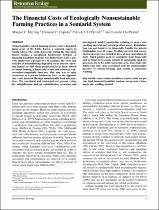 ResearchSpace
ResearchSpace
Financial costs of ecologically nonsustainable farming practices in a semiarid system
JavaScript is disabled for your browser. Some features of this site may not work without it.
- ResearchSpace
- →
- Research Publications/Outputs
- →
- Journal Articles
- →
- View Item
| dc.contributor.author |
Herling, MC

|
|
| dc.contributor.author |
Cupido, CF

|
|
| dc.contributor.author |
O'Farrell, PJ

|
|
| dc.contributor.author |
Du Plessis, L

|
|
| dc.date.accessioned | 2010-09-06T10:56:40Z | |
| dc.date.available | 2010-09-06T10:56:40Z | |
| dc.date.issued | 2009-11 | |
| dc.identifier.citation | Herling, MC, Cupido, CF, O’Farrell, PJ and Du Plessis, L. 2009. Financial costs of ecologically nonsustainable farming practices in a semiarid system. Restoration Ecology, Vol.17(6), pp 827-836 | en |
| dc.identifier.issn | 1061-2971 | |
| dc.identifier.uri | http://www3.interscience.wiley.com/journal/117979191/home?CRETRY=1&SRETRY=0 | |
| dc.identifier.uri | http://hdl.handle.net/10204/4333 | |
| dc.description | Copyright: 2009 Wiley-Blackwell. This is the post-print version of the work. The definitive version is published in the Restoration Ecology Journal, Vol.17(6), pp 827-836 | en |
| dc.description.abstract | Nonsustainable ostrich farming practices have degraded large areas of the Little Karoo, a semiarid region in South Africa. The Little Karoo lies within the Succulent Karoo biome, a recognized biodiversity hotspot. A financial feasibility analysis was undertaken from a private landowner’s perspective to examine the costs and benefits of rehabilitating degraded areas thereby allowing farmers to shift their production focus from ostrich to sheep farming, a financially stable and relatively conservation-compatible land use. Our aim was to raise awareness, at a private landowner level, to the opportunity costs incurred through unsustainable land use practices. We calculated and contrasted net present values for rehabilitation and no rehabilitation scenarios and investigated model sensitivities relating to seed costs, seedling survival and ostrich product prices. Rehabilitation was not found to be financially feasible for private landholders over 20 years. Seedling survival and associated seed costs were found to have strong controlling effects. Third parties need to contribute both financially and in terms of research outputs if sustainable land use practices are to be achieved in this area. This study elucidates the true costs associated with the unsustainable practice of ostrich farming and sounds a cautionary warning. | en |
| dc.language.iso | en | en |
| dc.publisher | Wiley-Blackwell | en |
| dc.subject | Conservation incentives | en |
| dc.subject | Seedling survival | en |
| dc.subject | Semi arid climates | en |
| dc.subject | Nonsustainable farming practices | en |
| dc.subject | Ostrich farming | en |
| dc.title | Financial costs of ecologically nonsustainable farming practices in a semiarid system | en |
| dc.type | Article | en |
| dc.identifier.apacitation | Herling, M., Cupido, C., O'Farrell, P., & Du Plessis, L. (2009). Financial costs of ecologically nonsustainable farming practices in a semiarid system. http://hdl.handle.net/10204/4333 | en_ZA |
| dc.identifier.chicagocitation | Herling, MC, CF Cupido, PJ O'Farrell, and L Du Plessis "Financial costs of ecologically nonsustainable farming practices in a semiarid system." (2009) http://hdl.handle.net/10204/4333 | en_ZA |
| dc.identifier.vancouvercitation | Herling M, Cupido C, O'Farrell P, Du Plessis L. Financial costs of ecologically nonsustainable farming practices in a semiarid system. 2009; http://hdl.handle.net/10204/4333. | en_ZA |
| dc.identifier.ris | TY - Article AU - Herling, MC AU - Cupido, CF AU - O'Farrell, PJ AU - Du Plessis, L AB - Nonsustainable ostrich farming practices have degraded large areas of the Little Karoo, a semiarid region in South Africa. The Little Karoo lies within the Succulent Karoo biome, a recognized biodiversity hotspot. A financial feasibility analysis was undertaken from a private landowner’s perspective to examine the costs and benefits of rehabilitating degraded areas thereby allowing farmers to shift their production focus from ostrich to sheep farming, a financially stable and relatively conservation-compatible land use. Our aim was to raise awareness, at a private landowner level, to the opportunity costs incurred through unsustainable land use practices. We calculated and contrasted net present values for rehabilitation and no rehabilitation scenarios and investigated model sensitivities relating to seed costs, seedling survival and ostrich product prices. Rehabilitation was not found to be financially feasible for private landholders over 20 years. Seedling survival and associated seed costs were found to have strong controlling effects. Third parties need to contribute both financially and in terms of research outputs if sustainable land use practices are to be achieved in this area. This study elucidates the true costs associated with the unsustainable practice of ostrich farming and sounds a cautionary warning. DA - 2009-11 DB - ResearchSpace DP - CSIR KW - Conservation incentives KW - Seedling survival KW - Semi arid climates KW - Nonsustainable farming practices KW - Ostrich farming LK - https://researchspace.csir.co.za PY - 2009 SM - 1061-2971 T1 - Financial costs of ecologically nonsustainable farming practices in a semiarid system TI - Financial costs of ecologically nonsustainable farming practices in a semiarid system UR - http://hdl.handle.net/10204/4333 ER - | en_ZA |





